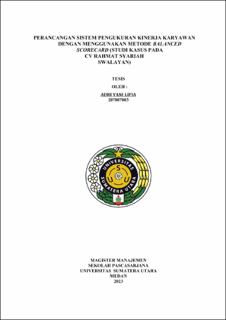Perancangan Sistem Pengukuran Kinerja Karyawan dengan Menggunakan Metode Balanced Scorecard (Studi Kasus pada CV Rahmat Syariah Swalayan)
Designing a Measurement System of Employee Performance Using Balanced Scorecard Method (A Case Study at CV Rahmat Syarjah Swalayan)

Date
2023Author
Lifia, Adri Yani
Advisor(s)
Lumbanraja, Prihatin
Sembiring, Meilita Tryana
Metadata
Show full item recordAbstract
Employee perfom1ance is an important element that each company must have.
The measurement of company pe,formance is one of a series conducted to achieve
company improvement. If a company wants to have a good performance
measurement, the first step that must be done is by designing it. CV Rahmat
Syariah Swalayan as a retail company is trying to improve its performance by
developing a performance measurement system using a Balanced Scorecard. The
company currently only uses the performance measurements of financial aspect
and employee performance, and these measurements are only used as a company
database. Therefore, they are unable to achieve company performance
improvement. The research aims to arrange the performance priority weights of
CV Rahmat Syariah Swalayan using analytical hierarchy process method and to
design a performance measurement system for CV Rahmat Syariah Swalayan
using the balanced scorecard method. This case study research is carried out to
analyze the quality or the causes and effects found in the research object using
qualitative research methods. Data is collected through interviews as well as by
distributing questionnaires and conducting documentary studies. The research
employs Analytical Hierarchy Process as weighting analysis technique. The
research stages are namely identifying the weight of company's performance
priorities, designing a perfom1ance measurement system so it is in line with the
company's vision, mission and goals. Therefore, several respondents are involved
in this research. After designing a performance measurement system using a
balanced scorecard, the importance level weight of each perspective are
calculated using the Analytic Hierarchy Process (AHP) method. The results of
data management indicate that there are 8 lagging indicators, JO leading
indicators, 9 strategy maps and 10 KP Is. The highest weight is in the customer
perspective (0.455%), the growth and learning perspective (0.263%), the
.financial perspective (0.141%), and the perspective of internal business process
(15.85%).
